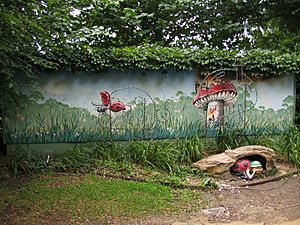Ladybird Ladybird facts for kids
Quick facts for kids "Ladybird Ladybird" |
|
|---|---|
| Nursery rhyme | |
| Published | c. 1744 |
| Songwriter(s) | Unknown |

"Ladybird! Ladybird!" is a very old and famous English nursery rhyme. It's also known in Germany with similar songs. This rhyme is listed in the Roud Folk Song Index as number 16215.
The Famous Rhyme
This traditional rhyme is all about ladybirds. These are bright, colorful insects. Many people think ladybirds bring good luck! The English version of the rhyme is at least as old as 1744. It first appeared in a book called Tommy Thumb's Pretty Songbook Vol. 2.
There are a few popular ways the rhyme goes:
- Ladybird, ladybird fly away home,
- Your house is on fire and your children are gone,
- All except one, and her name is Ann,
- And she hid under the baking pan.
A shorter, more serious version ends like this:
- Your house is on fire,
- Your children shall burn!
The child who hides in the rhyme might also be called Nan, Anne, or Little Anne. She could hide under a "warming pan", "porridge pan", "frying pan", or even a "pudding pan". Sometimes, her name is Aileen, and she hides in a "soup tureen".
There's even a different version from Peterborough. In this one, the child left behind is a boy:
- Ladybird, ladybird, fly away home, / Your horse is on foot, your children are gone;
- All but one, and that's little John, / And he lies under the grindle stone.
Different Names for the Insect
Ladybirds have many different names depending on where you are in Britain. For example, in Yorkshire, people used to say “Ladycow, Ladycow, ply thy way home”. The famous writer Charlotte Brontë called it a “lady-clock”.
In Scotland, a rhyme from the same time went like this:
-
- Dowdy-cow, dowdy-cow, ride away heame,
- Thy house is burnt, and thy bairns are tean.
In the USA, people often call them “ladybugs”. This name was first written down in 1699. However, the rhyme itself wasn't mentioned in America until the 1800s. It even appears in the book The Adventures of Tom Sawyer (1876). Sometimes in the USA, doodlebugs are used instead of ladybugs in similar rhymes. They are told to “Come out of your hole”.
The name "ladybird" has a special meaning. It refers to Mary, the mother of Jesus. She is often called "Our Lady". This connection is found in other European countries too. In Germany, the insect is called Marienkäfer, which means "Marybug". A German rhyme says: “Marybug, fly away, your house is on fire, your wee mother weeps” (Marienkäferchen, fliege weg! Dein Haüschen brennt, Dein Mutterchen flennt). Another German rhyme calls it Himmelsküchlichen, meaning "Sky-winger". It says: “Sky-winger, fly away, your house is in flames, your children together in tears” (Deiner Kinder weinen alle miteinander). In Sweden, the insect is called Jungfru Marias Nyckelpiga, which means "Virgin Mary’s keyholder". This also shows a religious link.
Ladybirds in Old Stories and Fun Facts
Because of the religious names, some people think the rhyme might be very old, possibly from the 1500s. They believe it might have been a warning during times when certain religious groups faced challenges. Another idea is that the rhyme connects to a story where Mary helped farmers. She supposedly sent ladybirds to eat pests that were destroying crops.
Farmers sometimes say this rhyme to protect the ladybirds. Ladybirds help crops by eating harmful insects. Farmers would say the rhyme before burning old crop fields. This was to make sure the helpful ladybirds flew away to safety.
Among children, it's a common and fun tradition. If a ladybird lands on you, you can gently place it on your hand. Then, you say the rhyme and make a wish as the ladybird flies away!
A different version of the rhyme was written by Mrs Southey in the early 1800s. It appeared in a magazine in 1827. This poem started like this:
-
- Lady-bird, Lady-bird, fly away home,
- The field mouse is gone to her nest,
- The daisies have shut up their sleepy red eyes
- And the birds and the bees are at rest
This poem continued with more verses about nature. Parts of it were printed in many books over the next hundred years. Even Emily Brontë used one verse at the start of one of her own poems.
- I. Opie and P. Opie, The Oxford Dictionary of Nursery Rhymes (Oxford University Press, 2nd edn, 1997), pp. 308–310


